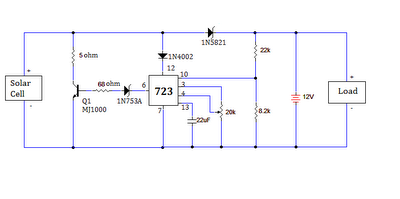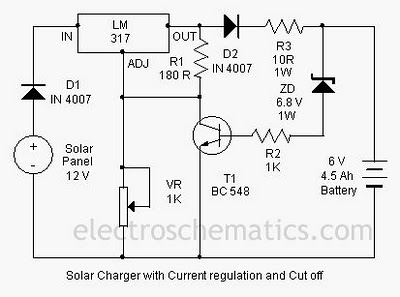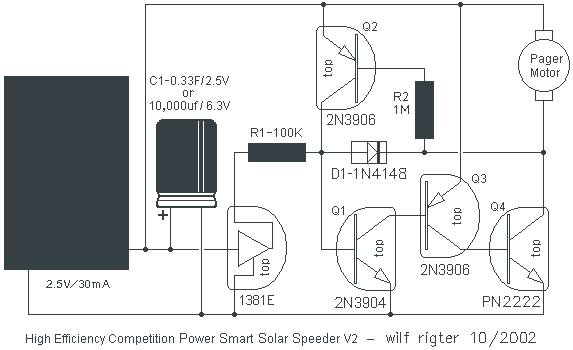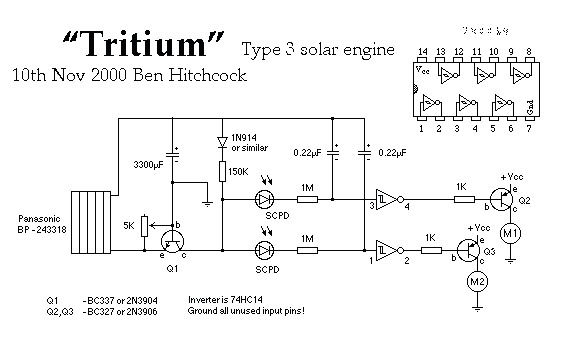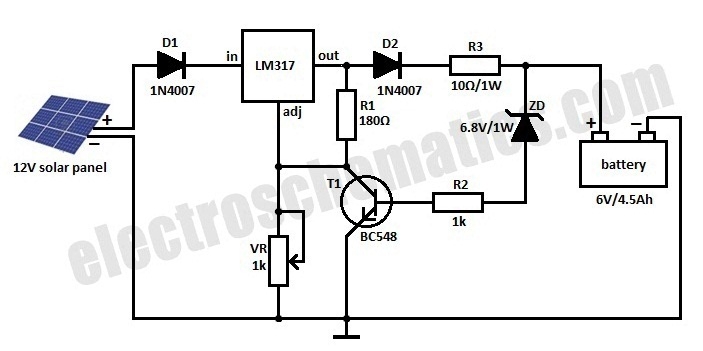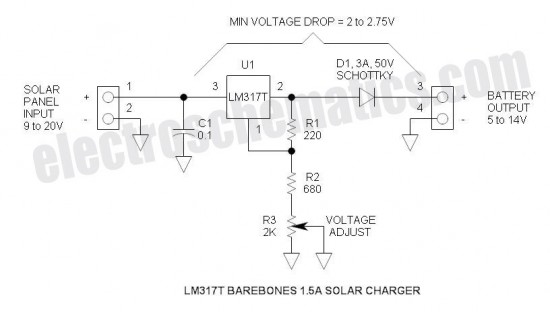
The Vx2SE solar engine
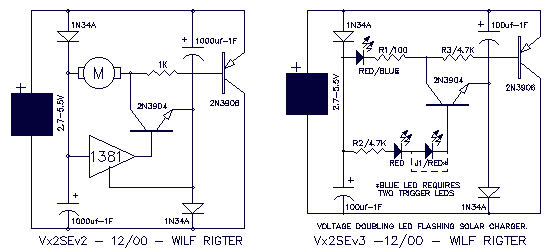
The Vx2SE is a simple discrete voltage-doubling SE for driving an LED. If the load is a red or green LED, J1 is used together with just one red or green LED for threshold detection (no 1381). For driving a blue LED use two green or red LEDs in series and may require a higher voltage (3V) solar cell. With 100uF capacitors the flash frequency is 2-3Hz and the R2 and R3 resistors may be omitted. With very large capacitors (0.01F and up) the frequency is much lower and the resistors can be optimized to stretch the LED "on" time.
The Vx2SE circuit is designed as a simple voltage-doubling circuit that utilizes discrete components to effectively drive light-emitting diodes (LEDs). The primary function of this circuit is to convert a lower input voltage into a higher output voltage, suitable for illuminating LEDs, which require a specific forward voltage to operate efficiently.
The circuit configuration allows for the use of a single LED when the load is either red or green. In this case, a threshold detection mechanism is achieved through the inclusion of connector J1, which serves as a pivotal point in the circuit for monitoring voltage levels without the need for an integrated circuit such as the LM1381. This simplifies the design and reduces component count, making it more accessible for hobbyists and engineers alike.
For applications involving blue LEDs, the circuit necessitates the use of two red or green LEDs connected in series. This configuration is crucial because blue LEDs typically require a higher forward voltage, often around 3V. Therefore, a solar cell capable of providing this voltage is recommended for optimal performance.
The circuit's operational characteristics can be adjusted based on the capacitance used. With a capacitance of 100µF, the circuit exhibits a flash frequency of approximately 2-3 Hz, which is suitable for applications requiring intermittent LED illumination. Resistors R2 and R3, which may influence the timing and brightness of the LED, can be omitted in this configuration, simplifying the design.
For applications requiring longer "on" times or lower flashing frequencies, larger capacitors (0.01F and above) can be employed. The increased capacitance results in a more extended discharge time, thereby lowering the flash frequency. In such cases, the values of resistors R2 and R3 can be optimized to tailor the LED's operational characteristics further, allowing for adjustments in brightness and on-time duration.
Overall, the Vx2SE circuit represents a versatile solution for driving LEDs with varying voltage requirements while maintaining simplicity and ease of use. It is particularly suitable for low-power applications and can be effectively powered by renewable energy sources such as solar cells.The Vx2SE is a simple discrete voltage-doubling SE for driving an LED. If the load is a red or green LED, J1 is used together with just one red or green LED for threshold detection (no 1381). For driving a blue LED use two green or red LEDs in series and may require a higher voltage (3V) solar cell.
With 100uf capacitors the flash frequency is 2-3Hz and the R2 and R3 resistors may be omitted. With very large capacitors (0.01F and up) the frequency is much lower and the resistors can be optimized to stretch the LED "on" time. 🔗 External reference
The Vx2SE circuit is designed as a simple voltage-doubling circuit that utilizes discrete components to effectively drive light-emitting diodes (LEDs). The primary function of this circuit is to convert a lower input voltage into a higher output voltage, suitable for illuminating LEDs, which require a specific forward voltage to operate efficiently.
The circuit configuration allows for the use of a single LED when the load is either red or green. In this case, a threshold detection mechanism is achieved through the inclusion of connector J1, which serves as a pivotal point in the circuit for monitoring voltage levels without the need for an integrated circuit such as the LM1381. This simplifies the design and reduces component count, making it more accessible for hobbyists and engineers alike.
For applications involving blue LEDs, the circuit necessitates the use of two red or green LEDs connected in series. This configuration is crucial because blue LEDs typically require a higher forward voltage, often around 3V. Therefore, a solar cell capable of providing this voltage is recommended for optimal performance.
The circuit's operational characteristics can be adjusted based on the capacitance used. With a capacitance of 100µF, the circuit exhibits a flash frequency of approximately 2-3 Hz, which is suitable for applications requiring intermittent LED illumination. Resistors R2 and R3, which may influence the timing and brightness of the LED, can be omitted in this configuration, simplifying the design.
For applications requiring longer "on" times or lower flashing frequencies, larger capacitors (0.01F and above) can be employed. The increased capacitance results in a more extended discharge time, thereby lowering the flash frequency. In such cases, the values of resistors R2 and R3 can be optimized to tailor the LED's operational characteristics further, allowing for adjustments in brightness and on-time duration.
Overall, the Vx2SE circuit represents a versatile solution for driving LEDs with varying voltage requirements while maintaining simplicity and ease of use. It is particularly suitable for low-power applications and can be effectively powered by renewable energy sources such as solar cells.The Vx2SE is a simple discrete voltage-doubling SE for driving an LED. If the load is a red or green LED, J1 is used together with just one red or green LED for threshold detection (no 1381). For driving a blue LED use two green or red LEDs in series and may require a higher voltage (3V) solar cell.
With 100uf capacitors the flash frequency is 2-3Hz and the R2 and R3 resistors may be omitted. With very large capacitors (0.01F and up) the frequency is much lower and the resistors can be optimized to stretch the LED "on" time. 🔗 External reference
Warning: include(partials/cookie-banner.php): Failed to open stream: Permission denied in /var/www/html/nextgr/view-circuit.php on line 713
Warning: include(): Failed opening 'partials/cookie-banner.php' for inclusion (include_path='.:/usr/share/php') in /var/www/html/nextgr/view-circuit.php on line 713
